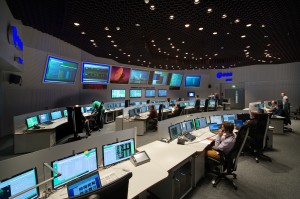ESA’s Christoph Steiger, the GOCE Spacecraft Operations Manager at ESOC, sent in this update earlier this morning.
Less than 1 day before the predicted re-entry into the atmosphere, the spacecraft is still functioning well and we are proceeding with our standard spacecraft operations activities.
GOCE is at roughly 147 km altitude this morning; the drop rate is greater than 1 km per hour and increasing.
Drag levels are now too high to be measured by the accelerometers. Based on the results of our orbit determination, early this morning they are around 165 mN average drag.
Temperatures of units and subsystems close to the front of the spacecraft keep increasing (by about 13 degC in the last 24h), but have not yet reached levels threatening the correct functioning of GOCE.
The orientation of the spacecraft is as it should be, with the attitude control system continuing to work well. Owing to its aerodynamic shape, we estimate that the spacecraft is by now being kept in the correct orientation by atmospheric drag forces alone, considering the extreme drag levels encountered (this morning about 15 times higher than what the spacecraft had been designed for).
The scientific GPS receivers of GOCE keep providing good data with no obvious signs of performance degradation.
It goes without saying that the performance of the spacecraft and the ground segment is much better than what we ever expected. However, given the fast altitude drop and change of environmental conditions, we are now getting very close to the end of flight operations.


Discussion: 4 comments
Will it be seen on the sky from norway when it enters?
wow, I would never have expected it to be still functioning at this point. Absolutely amazing and a tribute to excellent work.
Do you believe the s/c is amazingly still functioning because at lower drag (but still way outside of specs) it successfully remained stable, and now due to aerodynamic profile, drag is too high for it to easily tumble before structural failure? And thus temperature is still acceptable even for scientific instruments, and the main bus might hold until almost the very end? This is indeed very fascinating to watch for those last few hours.
Did it all burn out after reentering? Or land somewhere? I want some details after reentering, thank you!